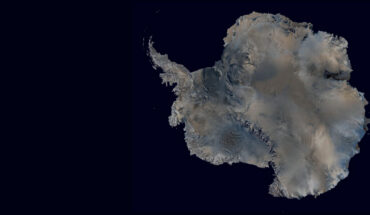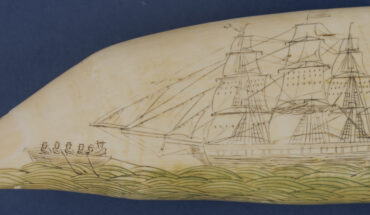
Telling time by lunar distances, the angle from the Sun to the Moon in the most common case, is an extension of one of the oldest methods of telling time: reading the phase of the Moon. Pre-modern cultures widely used the Moon for dates. In this image, we can tell the order of the images by date. The photos were taken each evening on Tuesday, Wednesday, and Thursday. They’re not in the correct order. Which one is Tuesday?
By Frank Reed
Mystic Seaport Museum offers one of the world’s best classes in both modern and historical celestial navigation. Among the classes is a unique workshop, “Celestial Navigation in the Age of Sail,” which focuses on 19th-century navigation in the whaling era using primary source evidence from the voyages of the Museum’s Charles W. Morgan. The Museum also offer the workshop “Lunars: Finding Longitude by Lunar Distances,” which is the only class in the history, modern practice, and science of lunars that is offered anywhere in the world.
The special celestial observations called lunars were once the epitome of the science of celestial navigation. In the late 18th century through the middle of the 19th century, when chronometers (accurate clocks for use at sea) were rare and expensive, navigators could use the Moon as a natural clock in the sky. As the Moon travels around the celestial sphere, making one revolution in a month, shifting from one constellation to another each night, navigators would measure its position relative to the Sun and stars and determine the absolute time, the so-called Greenwich Time, to the nearest 15-30 seconds. By comparing absolute time with local time, which was found from a simple altitude of the Sun or a star, navigators could determine their longitude, their distance east/west from the prime meridian at Greenwich.

From the logbook of the brig “Reaper” which was on a voyage from Boston to Yemen and India. This page shows some lunar work by Captain Isaac Hinckley, dated July 5, 1809.
In the logbook of the first voyage of the Charles W. Morgan in the early 1840s, we find instances where the crew recorded their longitude as determined by Lunar (often spelled eccentrically as “Luner”). Other logbooks in the collection of Mystic Seaport Museum, especially in earlier decades, include numerous examples of navigating by lunars.
Shooting a lunar was a bit art, a bit science, and a bit magic for a person aboard a vessel 150 to 250 years ago who was not trained in the method. A navigator would hold a sextant more or less sideways, catching the Sun or one of the standard lunars stars in the instrument’s primary view and rotating the sextant until the Moon appeared superimposed by reflection from the movable index mirror. Then by carefully, delicately adjusting the instrument, the Sun or star would be aligned until it just touched the bright limb or edge of the Moon. The exact angle in degrees, minutes, and seconds would then be read from the finely-engraved arc. With the measured angle in hand, the navigator would retire below deck to work some calculations, removing the effects of refraction and especially parallax (the shift in the Moon’s position caused by being relatively close to the Earth, only a quarter of a million miles away). The math might take 15 minutes. The cleared distance would be compared with pre-computed distances listed in the Nautical Almanac for every three hours of Greenwich Time. If the observed and corrected distance was some fraction of the angle between the listed distances, then the navigator knew that his or her own Greenwich Time was that same fraction through the three-hour interval.

Visually, looking through the sextant, the navigator would bring the Sun’s edge, or “limb,” into contact with the limb of the Moon. If the contact was exact, the time could be determined to within five seconds and the longitude would be right to the nearest mile or so. If the gap was as large as 0.3 minutes of arc as in this image (60 minutes of arc in one degree), then the error would be 36 seconds of time, and the longitude would be wrong by almost 10 miles.
Lunars died out slowly during the 19th century, at least in maritime practice, as chronometers, those exquisite marine clocks that could carry Greenwich Time around the world, became less expensive and more common. By the end of the 19th century, lunars had become so rare that Joshua Slocum, the first solo circumnavigator, bragged in 1899 about a single lunar observation performed near the Marqueses on his long voyage. In his Sailing Alone Around the World, Slocum wrote a nice epitaph for 19th-century lunars: “The work of the lunarian … is beautifully edifying, and there is nothing in the realm of navigation that lifts one’s heart up more in adoration.” Meanwhile, another author had declared lunars “as dead as Julius Caesar” in the previous decade!

An engraving from “Megarey’s Nautical Almanac” from 1843 illustrating in a quaint way the process of a lunar. The navigator aboard his de-masted vessel is holding a sextant and using it to bring a star across the sky into contact with the Moon’s limb thus measuring the lunar distance. The lunar distance provides absolute time or GMT. The navigator compares that with local time, frequently kept on a watch, which we see “floating” next to him
And yet even in the 21st century, when we have no need for them for time or longitude, navigators study and make themselves experts at lunars for the challenge and because they remain the ultimate test of a navigator’s skill with a sextant. To do lunars right, navigators must be masters of their sextants and of their math. And once we’ve learned the tricks, they’re fun, too! Lunars are much easier than their traditional reputation suggests, and any navigator can benefit from learning how to shoot and work them.
In the Lunar class at Mystic Seaport Museum, we cover the finer points of adjusting sextants and achieving the highest accuracy from the instruments. We look at the history using primary source materials from the Museum’s collection, and we learn about the intriguing math and science that makes these sights possible and practical. We even discuss the strange renaissance in lunars that occurred in the late 1960s when astronauts shot lunars on their way to the Moon. Weather-permitting, we shoot lunars from the deck of the Charles W. Morgan, just as those early crews did in the middle of the 19th century.
Frank Reed has taught navigation classes at Mystic Seaport Museum for more than a decade. He is a recent guest expert in celestial navigation on Neil deGrasse Tyson’s StarTalk science talk show on the National Geographic Channel.


